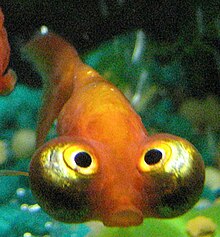Celestial Eye
 | |
| Country of origin | China or Korea |
|---|---|
| Type | Fantailed |
| Classification | |
| AGA | [1] |
| BAS | [2] |
Celestial eye goldfish or Choutengan
Origins
Celestials first appeared as a direct

Description
The Celestial is a goldfish that has an elongated egg-shaped body similar to the
Despite their limited vision and their lack of a dorsal fin, they are active and agile swimmers. They do require some special attention since, in addition to having easily damaged upward-oriented eyes (and, as a result, having limited vision), they are sensitive to cold water temperatures. They are unable to compete with more vigorous goldfish for food. Sharp ornaments and objects in the aquarium are inadvisable. They are best kept with other limited-vision breeds (e.g. the Bubble Eye) or in a tank of their own.[2][5]
Variants
The original Celestial breed, described above, is still bred and exported by Chinese and Japanese breeders and is commercially available to fanciers, though they are not as commonly stocked by aquarium shops and dealers as some other goldfish varieties. It is this 240+ year old form that is described in the American standard adopted by the American Goldfish Association and the Goldfish Society of America. British fanciers prefer their Celestials to have deeper bodies and shorter fins, and have selectively bred for these features as required by the British standard. Standard Celestials are ugly, but the Chinese have crossed Celestials with several other breeds, most commonly Lionheads, Ranchus and Pompoms, producing much larger fish with short ranchu-like fins and very deep, blocky bodies, often with nasal 'bouquets' (pompoms) and rudimentary head growths.
Some of these crosses tend to be less animated swimmers, especially those that possess a short, sharply downturned, ranchu-like
See also
References
- ^ ""Fishes in Nature and in the Aquarium" from Nutrafin News Aquatic magazine, Rolf C. Hagen (U.S.A.) Inc. and Rolf C. Hagen Corp. (Montreal, Canada), Issue #4, 2004". Archived from the original on 2011-11-21. Retrieved 2007-05-25.
- ^ ISBN 1-902389-64-6
- ^ Free Information Keeping Celestial Eye Goldfish
- ^ "The Sacred Fish of Korea," by William T. Innes, Aquarium Highlights, Innes Publishing Co. Philadelphia, 1951
- ISBN 0-8348-0448-4
- Innes, Dr William T."The Sacred Fish of Korea," Aquarium Highlights, Innes Publishing Co. Philadelphia, 1951.
- Innes, Dr. William T. Goldfish Varieties and Tropical Aquarium Fishes, 9th Edition, Innes Publishing Co, Philadelphia, 1926.
- Matsui, Dr. Yoshiichi, Goldfish Guide, 2nd Edition, TFH Publications, Inc, Neptune, N.J. 1981
- Hervey, G.F. & Hems, J. The Goldfish, 1st Edition, Batchworth Press, London, 1948.
